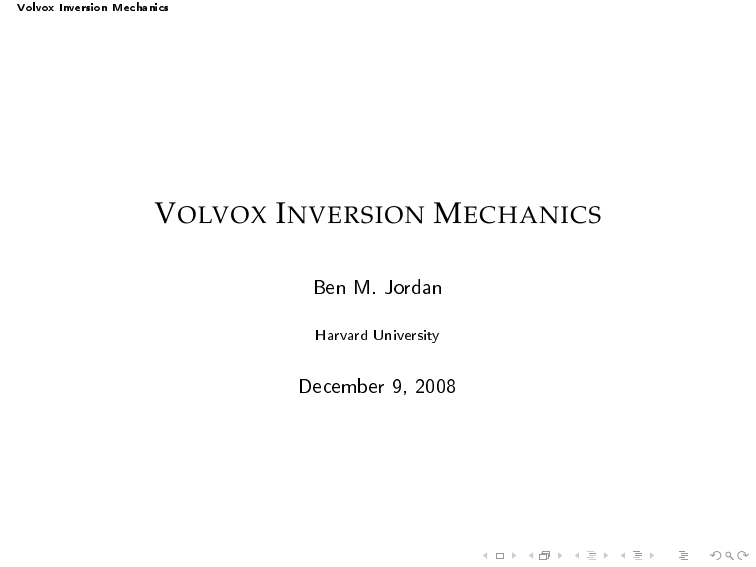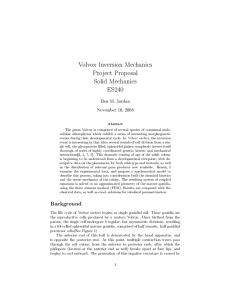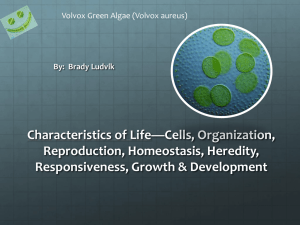V I M OLVOX
advertisement

Volvox Inversion Mechanics V OLVOX I NVERSION M ECHANICS Ben M. Jordan Harvard University December 9, 2008 Volvox Inversion Mechanics O UTLINE 1 B ACKGROUND 2 M ATHEMATICAL M ODEL 3 R ESULTS 4 F UTURE W ORK Volvox Inversion Mechanics Background O UTLINE 1 B ACKGROUND 2 M ATHEMATICAL M ODEL 3 R ESULTS 4 F UTURE W ORK Volvox Inversion Mechanics Background W HAT IS Volvox carteri? Chlorophycaean family Fresh water globular algae and algal community comprised of 2000+ cells Biagellate individuals cells held together by cytoplasmic bridges and extracellular matrix (ECM) Posterior < > Anterior Volvox Inversion Mechanics Background W HY STUDY Volvox carteri? Model system for studying multicellular tissues and epithelial sheet movements, which occur in processes such as gastrulation and notochord formation in vertebrates, such as humans. Rich quantitative literature with genetic, developmental, and evolutionary data Several developmental mutants and techniques are available for experiment Volvox Inversion Mechanics Background D EVELOPMENT Single celled individuals (gonidia) hatch from adult and are motile Several (11-12) rounds of volume increase and division (cleavage) Both somatic (body) and gametic (reproductive) cell types are dierentiated during this process A single anterior-posterior axis over the entire colony develops Volvox Inversion Mechanics Background P RE - INVERSION After 5th cleavage cycle (=32 cells), half of the anterior 16 cells dierentiate into gonidia precursors. The gonidia precursors undergo 3 more rounds of division, resulting in (8,16,32)=64 gonidia pre-inversion The somatic cells divide 6-7 more times, depending on environmental conditions, resulting in (24,48,96,192,384,768,1536)=3072 maximum cells pre-inversion Somatic cells are 1 10 th of the volume of the gonidia, and are connected via 25000 cytoplasmic bridges, forming a continious epithelial sheet Gonidia are on the outside before inversion Volvox Inversion Mechanics Background I NVERSION Actually, it's an eversion... Between the 3rd and 4th round of cleavage, a swastika-shaped opening develops in the anterior side of the epithelial sheet. Somatic cell geometry changes from ellipsoidal to ask-shaped, causing negative curvature Geometry change passes as wave from anterior to posterior, resulting in a curling epithelium Once the curl passes over the anterior/posterior (A/P) midline, the posterior half contracts, and pops through the opening The epithelium reconnects to itself, completing the inversion Volvox Inversion Mechanics Background G EOMETRY C HANGES IN S OMATIC C ELLS Transverse section of inversion process, with anterior on top. Somatic cells change from ellipsoidal to ask shaped, extending inward. Due to the decrease in circumference and conservation of volume, the sheet bends outward Cells change back from ask-shaped to ellipsoidal after a few minutes Wave of geometry change stops at A/P midline Entire process takes about 45 minutes Volvox Inversion Mechanics Background Q UESTIONS Does the geometry change of the anterior somatic cells account for the entire inversion? Does the posterior actomyosin contraction account for the inversion? What role does geometry play in this process? What role do protein kinetics play in this process? Volvox Inversion Mechanics Mathematical Model O UTLINE 1 B ACKGROUND 2 M ATHEMATICAL M ODEL 3 R ESULTS 4 F UTURE W ORK Volvox Inversion Mechanics Mathematical Model A SSUMPTIONS Treat epithelial sheet as continuous media. This is justied due to cytoplasmic bridges and high cell count. Treat epithelial sheet as deformations. linear elastic, accounting for large There is currently no data on the viscous response of the epithelial sheet. Although the organism is completely surrounded by, and lled with water, uid eects on the inversion process are considered to be minimal. I.e. I consider the dynamics of the solid epithelial sheet in a vacuum. Volvox Inversion Mechanics Mathematical Model E QUATIONS AND PARAMETERS Momentum Balance: ∂σij ∂ xj Strain-Displacement: Hooke's Law: 2 + bj = ρ ∂∂tu2 ε ij = 12 i ∂ ui ∂ xj ∂u + ∂x j i +ν σ − ν σ δ + α∆T ε ij = 1E ij E kk ij Reaction-Diusion: Young's Modulus (E ): Poisson Ratio (ν): ∂c ∂t = D ∇ 2 c + fR ( c , x ) 5 10 Pa 0.49 Note: Although spherical coordinates should be the obvious choice for solving this problem, rectilinear coordinates are used due to the FEM package used. Volvox Inversion Mechanics Mathematical Model S INGLE C ELL S HAPE C HANGE G EOMETRY A single cell experiences a contraction on one side, and an expansion on the other, resulting in the ask shaped change we observe. Volvox Inversion Mechanics Mathematical Model L INE / A RC OF C ELLS G EOMETRY A single straight line of cells (in series) is used to model the ellipsoid-ask-ellipsoid travelling wave observed experimentally The travelling wave was modeled using a volume increase equivalent to thermal expansion. The equation used to represent this is Volvox Inversion Mechanics Mathematical Model 2D/3D P OSTERIOR G EOMETRY Surgical mutant removes anterior half, and inversion still occurs Posterior inversion is controlled by actomyosin contraction Combined with anterior half, the contraction + the geometry change can explain the entire inversion. Volvox Inversion Mechanics Results O UTLINE 1 B ACKGROUND 2 M ATHEMATICAL M ODEL 3 R ESULTS 4 F UTURE W ORK Volvox Inversion Mechanics Results S INGLE C ELL S HAPE C HANGE Volvox Inversion Mechanics Results L INE / A RC OF C ELLS Fixed Line of Cells Travel- file:///F:/SolidsES240/project/ lineCellsElongationWave.avi ling Elongation Wave Volvox Inversion Mechanics Results P OSTERIOR I NVERSION - 2D Plain strain approximation is used, and doesn't reect actual geometry properly Change in geometry due to contraction begins properly Failure due at larger deformation requires further investigation Volvox Inversion Mechanics Results P OSTERIOR I NVERSION - 3D This plot is the von Mises stress after contraction Volvox Inversion Mechanics Future Work O UTLINE 1 B ACKGROUND 2 M ATHEMATICAL M ODEL 3 R ESULTS 4 F UTURE W ORK Volvox Inversion Mechanics Future Work O PEN QUESTIONS Compare stress and pressure results to see if they are of the right magnitude. Viscoelastic tissue model may help account for the maintainence of curvature ofter cell shape change 2D model helps to understand cell geometry change, but doesn't account for the pop-through event of the posterior. Singularities develop in plastic and FEM models of full inversion at the A/P midline. How does the organism overcome this? Discreteness of cells and bridge rearrangement may account for this. Studies of curved sheets may be helpful here. Comparison with discrete truss model may be useful, and would account for cytoplasmic bridges more accurately. Rheological study of the cell sheet may be useful Volvox Inversion Mechanics Future Work G ENERALIZE TO OTHER V OLVOCACEAN INVERSIONS Other species of Volvox exhibit inversion as well Gastrulation in Xenopus laevis is model for vertebrate gastrulation; a process that is essential in many higher organisms Volvox Inversion Mechanics Future Work T HIN 2D S HELLS VS . T HIN 3D S HELLS Thin shell theory has been used to describe cell walls, epithelial layers, and other thin biological membranes Thin shell theory is implemented as a 2D sheet that interacts with 3D structures as a boundary These thin shells can also be modeled as 3D sheets, with a single layer of elements in the thickness. Are these equivalent? Which is more accurate for large, nonlinear deformations? Snapping Membrane file:///F:/SolidsES240/project/snapMembrane.avi Volvox Inversion Mechanics Future Work T HE E ND





